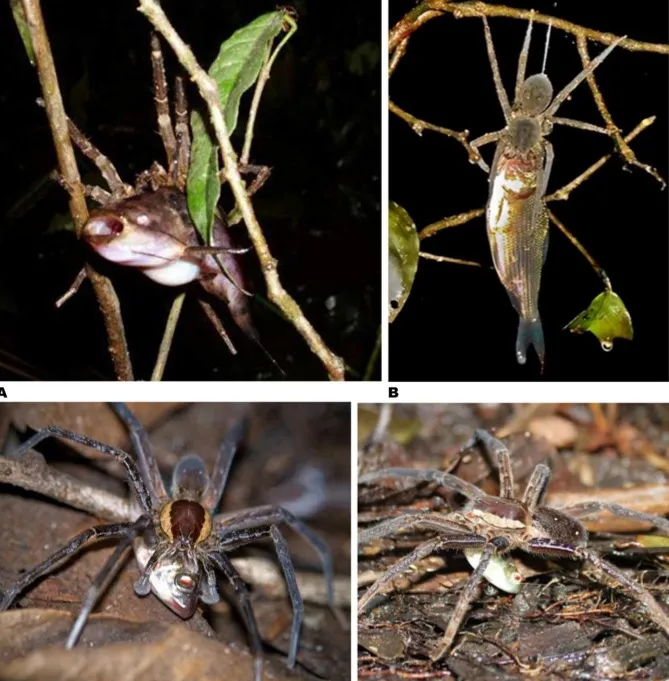Spiders All Over the World Have a Taste for Fish
Eight-legged predators probably prey on vertebrates much more often than arachnologists previously assumed
/https://tf-cmsv2-smithsonianmag-media.s3.amazonaws.com/filer/31/40/314060ad-6313-4afd-8537-87c3ef1e7f4a/spider_fish.jpg)
A common argument used to soothe arachnophobic individuals is that spiders eat pesky insects that are actually more bothersome than those much-loathed eight-legged creatures themselves. Spiders will regularly consume other invertebrates, including fellow spiders, mosquitoes, roaches, flies, fleas, clothes moths, earwigs and other pests, fostering a tenuous camaraderie with humans along enemy-of-my-enemy lines.
Vertebrates—the cuddly creatures that people tend to relate to best and love the most—are clearly not on spiders’ menus.
Or are they?
According to new research published in PLoS One, dozens of spider species around the world have an unexpected craving for fish. “The notion of fish-catching spiders is rather peculiar if we consider that spiders, as a whole, are traditionally viewed as the classic example of a predator that feeds on insects,” the authors of the new paper write, “yet some spiders are well-adapted for life near, or on, the water surface.”
Previously, researchers knew of one such type fish-feasting of spider, appropriately called fishing spiders. The two authors of this new study, however, suspected there was more to the story than that famous example. Semi-aquatic spiders live on all continents except Antarctica (though 90 percent occur in warmer climates). These spiders crouch on the edges of streams, rivers, lakes, ponds, bayous and swamps, or hang out on exposed aquatic vegetation. Surely some of these arachnids also are pescatarians?
They conducted a worldwide literature search of all records of spiders feeding on fish, combing through both published and unpublished accounts. They searched photography archives and interviewed specialists who might have stumbled across the eight-legged phenomenon in their studies, including aquatic ecologists, ichthyologists and wildlife photographers.
Based on these accounts, the authors found that when an unsuspecting guppy, minnow or mosquito fish swims by, semi-aquatic arachnids do dive in and snatch it up. Some spiders also play go-fish up while balancing on the water’s surface. The spiders’ prey range from about one to two inches, and the fish are almost always about twice as big as the spider itself.
The researchers document more than 80 instances of this happening—including from observations in the field and in laboratory tests—in spider species belonging to eight different taxonomic families. The behavior was observed in the wild on every continent where the spiders live.

The practice’s surprising prevalence makes the authors suspect that fishing likely plays a role in helping some spider species survive, even if fish is more of a delicacy rather than an every-day snack. “Fish might be an occasional prey item of substantial nutritional importance,” the authors write.
The vertebrate picnic, however, probably doesn’t end with fish, the authors point out. Arachnologists are gathering more and more evidence that some large spiders don’t hesitate to snatch up back bone-bearing prey, if given the chance.
For example, the Goliath birdeater—contrary to its name—does not eat birds, but it is known to suck the juices out of rodents, frogs, lizards and snakes when its preferred diet of cockroaches is in short supply.
Other spiders, however, do enjoy feasting on birds and other flying vertebrates: Orb weavers in particular are known to sometimes snare humming birds in their webs (pdf) and then quickly get to work wrapping those feathered victims in steel-like silk (think dwarves in Mirkwood forest). Bat-catching spiders (also usually voracious orb weavers) not only trap those winged mammals, but actively hunt them.
Humans, however, are still a few orders of magnitude too large to find a place on the spider menu. Unless, that is, giant monster arachnids emerge from hiding to take over the world.
/https://tf-cmsv2-smithsonianmag-media.s3.amazonaws.com/accounts/headshot/Rachel-Nuwer-240.jpg)
/https://tf-cmsv2-smithsonianmag-media.s3.amazonaws.com/accounts/headshot/Rachel-Nuwer-240.jpg)